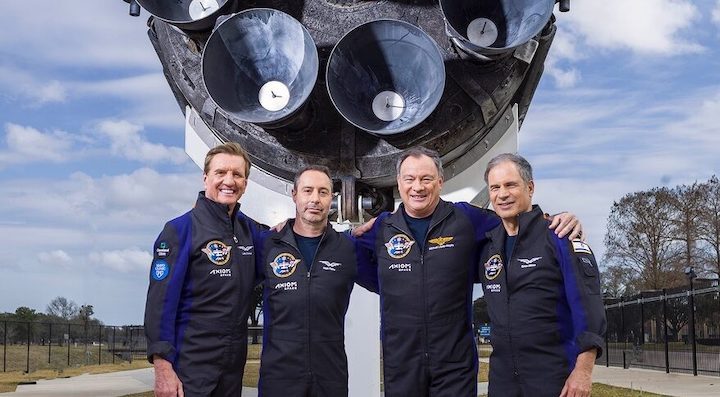15.05.2022

The Ax-1 crew of (from left) Larry Connor, Mark Pathy, Michael López-Alegría and Eytan Stibbe said they were overly aggressive in planing how much they could done on the ISS, especially in their first few days after arriving there in April. Credit: Axiom Space
WASHINGTON — The private astronauts who spent two weeks on the International Space Station in April said they tried to pack too much into their schedules while on the station, putting a strain on both themselves and the professional astronauts there.
At a May 13 news conference, the four people who flew on Axiom Space’s Ax-1 mission to the station said that while they had a good trip to the station, they overestimated how much work they could get done after their arrival at the ISS April 9 for what was originally scheduled to be an eight-day stay.
“Our timeline was very aggressive, especially early in the mission,” said Michael López-Alegría, the former NASA astronaut and current Axiom employee who commanded Ax-1. “The pace was frenetic in the beginning.”
“With the value of hindsight, we were way too aggressive on our schedule, in particular the first couple days,” said Larry Connor, one of the three customers who accompanied López-Alegría on Ax-1. He gave an example of one experiment that was scheduled to take two and a half hours to complete based on preflight training but ended up taking five hours.
López-Alegría thanked the four Crew-3 astronauts from NASA and the European Space Agency who were on the station during their visit for assistance, calling them “extraordinarily helpful, gracious, kind, sharing” during their stay. “I can’t say enough good things about them, and we really needed them.”
That had an impact on the Crew-3 astronauts’ own work schedule. During a May 12 meeting of the Aerospace Safety Advisory Panel, Susan Helms, a former NASA astronaut who serves on the panel, said the Ax-1 visit posed “no apparent overt safety issues” but that it did affect the performance of the astronauts.
“There were some real-time dynamics related to the flight crew timelines with the addition of these four Axiom personnel, who did have their own flight objectives,” she said. “In essence, the arrival of the Axiom personnel seemed to have a larger-than-expected impact on the daily workload on the professional International Space Station crew.”
While the Ax-1 mission did allow for some new science, and the ability to transport some NASA cargo back to Earth, “there was also some opportunity cost in the form of overly stressing the workload of the onboard ISS members and the mission controllers who support them on the ground,” Helms said. She recommended that future private astronaut missions be managed in “normalized processes” that fully integrate them into overall ISS activities.
“It’s incumbent on us to reduce our burden on the crew,” said Michael Suffredini, president and chief executive of Axiom Space, at the news conference, saying that was part of “lessons learned” discussions with NASA and SpaceX that will inform future missions to the station. “Over time, we’ll reduce what the crew has to do.”
One way to reduce that burden is to stretch out the work over a longer stay. The Ax-1 mission ended up spending more than 15 days at the ISS, rather the original 8 days, because of unfavorable weather conditions at landing sites off the Florida coast.
“It was a blessing to have the extra time,” López-Alegría said. “I think we were so focused on research and outreach in the first 8 or 10 days on orbit that we needed the extra time to complete the experience by having time to look out the window, to make contact with friends and family, to just enjoy the sensation.”
Suffredini said longer missions would have to fit into a busy schedule on the ISS and address issues such as effects on the life support system of having 11 people there for an extended period. He did note, though, that Axiom has planned 30-day missions to the station and would like to go as long as 60 days.
“This flight was really wildly successful,” he said. “From our perspective, we will go be a little more efficient, train a little differently, do a few things to help out the timeline.”
He added the company had sold three seats on future missions since Ax-1, which included an agreement announced April 29 with the United Arab Emirates to fly an Emirati astronaut on a long-duration mission using a seat provided by NASA in exchange for a Soyuz seat Axiom had previously purchased from Roscosmos. He declined to disclose the other customers who signed up.
Quelle: SN
